1978 FIFA World Cup
| Copa Mundial de Fútbol Argentina '78(Spanish) | |
|---|---|
 | |
| Tournament details | |
| Host country | Argentina |
| Dates | 1–25 June |
| Teams | 16 (from 5 confederations) |
| Venue(s) | 6 (in 5 host cities) |
| Final positions | |
| Champions | |
| Runners-up | |
| Third place | |
| Fourth place | |
| Tournament statistics | |
| Matches played | 38 |
| Goals scored | 102 (2.68 per match) |
| Attendance | 1,545,791 (40,679 per match) |
| Top scorer(s) | |
| Best player(s) | |
| Best young player | |
| Fair play award | |
The1978 FIFA World Cupwas the 11th edition of theFIFA World Cup,aquadrennialinternationalfootballworld championship tournament among the men's senior national teams. It was held in Argentina between 1 and 25 June.
The Cup was won by the host nation,Argentina,who defeated theNetherlands3–1 in the final, afterextra time.The final was held atRiver Plate's home stadium,Estadio Monumental,in the Argentine capital ofBuenos Aires.This win was the first World Cup title for Argentina, who became the fifth team (afterUruguay,Italy,England,andWest Germany) to be both hosts and world champions and the third South American team to win a World Cup. Argentina, the Netherlands, and Brazil were the gold, silver, and bronze medalists, respectively. Iran and Tunisia made their first appearances in the tournament. The defending champions,West Germanywere eliminated in the second round (finishing third in their group). This was also the last World Cup tournament to use the original inclusion of 16 teams. Since the first World Cup in1930,only 15 teams (plus the host, who automatically qualified) had been allowed to qualify (the reigning title holders also received automatic qualification from 1934 through 2002); but for the next World Cup,in Spain,FIFA expanded that tournament to 24 teams.
This tournament was marred by flagrant controversy, domestic politics, and alleged interference and match-fi xing by the Argentine authoritarian military junta government, who wereusing this tournament as an opportunityfor nationalistic propaganda, and for the relatively new military junta to seek legitimacy on the world stage.[3]During the months before the start of the World Cup, the junta was intending to dismantle those who were against them and mitigate criticism from the public on their policies.[4]
The official match ball was theAdidas Tango.
Host selection[edit]
Argentina was chosen as the host nation by FIFA on 6 July 1966 in London, England when the hosts for1974,1978 and1982editions were chosen. Mexico withdrew from the bidding process after having been awarded the1970 eventtwo years earlier.
The logo is based onPresidentJuan Perón's signature gesture: a salute to the crowd with both arms extended above his head. This was one of the most famous, populist images of Perón. The design was created in 1974, two years prior to themilitary coup in 1976.The military leadership were aware that the World Cup's logo symbolized Perón's gesture, and they tried to change the competition's logo. At this point, the design was already broadly commercialized and the merchandise had already been made: a forced modification "would trigger a sea of lawsuits against the country", so the military had no option but to give up their attempts and leave it.[5]
The monetary cost of preparing to host the World Cup was put at $700 million, including building three new stadia and redeveloping three others; building five press centres; a new communications system costing $100 million; and improvements to transport systems.[6]
Qualification[edit]
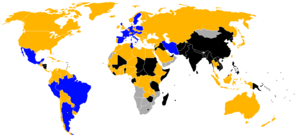
England, Belgium, Czechoslovakia (theEuropean champions) and the Soviet Union failed to qualify for the second World Cup in succession, losing out to Italy, the Netherlands, Scotland and Hungary respectively. 1974 quarter-finalists East Germany and Yugoslavia were eliminated by Austria and Spain and thus also failed to qualify for the finals, along with Bulgaria which failed to qualify for the first time since 1958 after losing to France. Bolivia's win meant Uruguay also failed to qualify for the first time since 1958. Newcomers to the finals were Iran and Tunisia; Austria qualified for the first time since 1958, while France, Spain and Hungary were back for the first time since 1966. Peru and Mexico returned after missing the 1974 tournament. For the first time, more than 100 nations entered the competition.[7]
List of teams qualifying[edit]
The following 16 teams qualified for the final tournament:
Controversy[edit]
A controversy surrounding the 1978 World Cup was that Argentina had undergone amilitary coupof its democratic government only two years before the cup, which installed a dictatorship known as theNational Reorganization Process.Between the time that the military junta took over the government and the time the World Cup started, foreign journalists were concerned about how Argentinian newspaper reporters and editors were being treated by the regime, in attempting to get leftist members out of the picture. The new government targeted any parts of society that they saw were trying to undermine them.[4]Less than a year before the World Cup, in September 1977, Interior Minister GeneralAlbano Harguindeguy,stated that 5,618 people had recently disappeared. The infamous Higher School of Mechanics of the Navy (known by its acronymESMA) held concentration camp prisoners of theDirty Warand those held captive reportedly could hear the roars of the crowd during matches held at River Plate's Monumental Stadium, located only a mile away;[8]prompting echoes of Hitler's and Mussolini's alleged political manipulation of sports during the1936 Berlin Olympicsand1934 FIFA World Cup.[9]Also, the junta practiced censorship since it was established, which encouraged less reports on the real situation in Argentina. This was done as an attempt to change the character of the Argentinian people.[4]
Just months before the World Cup, the Argentinian regime launched a campaign to silence any disapproval of the government from the people. However, over the course of the tournament, the regime ceased the operation to avoid giving off their authoritarianism and receiving criticism from all over the world, but international newspapers and human rights organizations have already criticized Argentina as host for the next World Cup.[10]Because of the political turmoil, some countries, most notably theNetherlands,considered publicly whether they should participate in the event. Despite this, all teams eventually took part without restrictions. However, most notably, Dutch starJohan Cruyff,who won theGolden Ballin the previous1974 FIFA World Cup,refused to take part in the 1978 World Cup, even though he earlier participated in the1978 FIFA World Cup qualification.Allegations that Cruyff refused to participate because of political convictions were denied by him 30 years later—he and his family had been the victims of a kidnapping attempt a few months before the tournament. Several criminals entered his house in Barcelona at night and tied him and his family up at gunpoint.[11]The only player who missed the tournament for political reasons, was the West GermanPaul Breitner.[12]One player,Ralf Edström,was arrested for speaking to someone inBuenos Aires;however, the Argentine military released him upon recognizing that he was a Swedish footballer, not an ordinary person. More controversy surrounded the host, Argentina, as all of their games in the first round kicked off at night, giving the Argentines the advantage of knowing where they stood in the group. This issue would arise again in Spain 1982, which prompted FIFA to change the rules so that the final two group games in subsequent World Cups (as well as in every other international tournament, starting with theUEFA Euro 1984) would be played simultaneously.
The military forces that had control over Argentina at the time wanted to hold that power for as long as they could, but with a different perspective. The use of repression, torture, kidnapping, and assassination was becoming an everyday reality, with 30,000 people murdered between 1976 and 1983, the end of the dictatorship.[13]People wondered why FIFA would allow the World Cup to go on under these circumstances and that 15 other countries, most of which are old democracies, would participate in the tournament. However, it is simply because of the dominant notion that football or soccer, or any sport for that matter, belong to civil society, giving the assumption that state policies wouldn't interfere with the passion and enthusiasm of fans.[13]
Argentina's controversial and favorable decisions in their matches have caused many to view their eventual win as illegitimate; many cite the political climate and worldwide pressure on the Argentine government as the reason for these decisions. Desperate to prove their stability and prominence to the world after their coup two years earlier, the government used whatever means necessary to ensure that the team would progress far in the tournament.
Suspicions of match fi xing arose even before the tournament began;Lajos Baróti,the head coach of Argentina's first opponents,Hungary,said that "everything, even the air, is in favor of Argentina".[14]He also talked about the financial imperative to have Argentina win the World Cup: "The success of Argentina is financially so important to the tournament".[14]
From Will Hersey's article "Remembering Argentina 1978: The Dirtiest World Cup of All Time":
The other teams in Argentina and Hungary's group were the much-fancied France and Italy, establishing the tournament's toughest qualifying section. After the victory against Hungary, one junta official remarked toLeopoldo Luquethat "this could turn out to be the group of death as far as you are concerned." It was delivered with a smile. "Uppermost in my mind was that earlier that day, the brother of a close friend of mine had disappeared", recalled Luque. "His body was later found by villagers on the banks of the River Plate with concrete attached to his legs. At that time, opponents of the regime were sometimes thrown out of aeroplanes into the sea."[14]
In their second group stage game againstFrance,Argentina were the beneficiaries of multiple favourable calls. After France were denied what looked to be a clear penalty in the first half, an anonymous French player said he had heard the referee tellDaniel Passarella(the player who committed the foul), "Don't do that again please, or I might have to actually give it next time."[15]
Protests[edit]
Amnesty International announced their strategy for Argentina in 1978. After their awareness that urging people away from the World Cup could produce counter-sympathy for the junta, they launched a campaign that would teach journalists to write about the tournament but based on the regime, along with the slogan "Football yes, torture no." They hoped that the journalists would turn their eyes away from the matches and look at what's going on in their society to educate their readers on the reality of Argentina.[4]Paris was a center of unanimity for the victims of the Argentinian dictatorship, which launched a campaign to boycott the 1978 World Cup. In the city, they made posters, publications or any kind of information that expressed opposition to the World Cup under a dictatorship. The first calls to boycott were published in the dailyLe Mondein October 1977. Later, a boycott committee was organized, which brought together human-rights militants and left-wing activists. This organization came to be known as COBA, a French acronym for, "Committee for the Boycott of the World Cup in Argentina." It wasn't long before the COBA had established a strong base of unity and protest throughout France, with more than 200 local COBA committees created in major cities and provinces.[16]
Argentina v Peru[edit]
Further accusations have surrounded the game Argentina and Peru played in the second round of the tournament. Following Brazil's 3–1 win over Poland, Argentina needed to win by a margin of four goals to proceed to the final and did so by defeating Peru by 6–0. There were allegations that the authoritarian Argentine military government interfered to ensure Argentina would defeat Peru through intimidation, though these were denied by Peruvian captainHéctor Chumpitazand several Peruvian players.[17]Some accusations originated in the Brazilian media and pointed to the fact that the Peruvian goalkeeper,Ramón Quiroga,had been born in Argentina.[18][19]There was also an alleged deal, reported by the British media as an anonymous rumour, that involved the delivery of a largegrain shipmentto Peru by Argentina and the unfreezing of a Peruvian bank account that was held by the Argentine Central Bank.[20]Another alleged deal, published by a Colombian drug lord in a controversial book, involved the Peruvian team being bribed without any political implications.[17]A third alleged deal, stated by a Peruvian leftist politician, encompassed sending 13 Peruvian dissidents exiled in Argentina back to Peru.[21]
Three months before the World Cup, Argentina had beaten Peru 3–1 in Lima, their head-to-head record was 15–3 in favour of the host nation, and Peru had never beaten Argentina away from home. However, Peru had conceded only six goals in their previous five games in the World Cup. During the first half, Peru hit the post twice after two counters when the game was 0–0. Argentina managed to get 2–0 ahead before the end of the first 45 minutes. During the second half, Argentina was 4–0 ahead when Peru had another clear chance. Argentina kept attacking and scored twice more, making it 6–0 and surpassing the required margin.
There was also some domestic controversy as well, as Argentine managerCésar Luis Menottidid not call up the then-17-year-oldArgentinos Juniorslocal starDiego Maradona,for Menotti felt Maradona was too young to handle the pressures of such an important tournament on home soil and that the expectations of the team's performance would probably revolve around the Buenos Aires-born youngster.[22]In addition, Maradona's usual position of number 10 (play-making attacking midfielder) was taken byMario Kempes,who ended up as the Best Player and Top Goal Scorer.
Format[edit]
The format of the competition stayed the same as in1974:16 teams qualified, divided into four groups of four. Each group played around-robinwith two points for a win and one for a draw, and goal difference used to separate teams level on points. The top two teams in each group would advance to the second round, where they would be split into two groups of four. The winners of each group would play each other in the final, and the second-place finishers in the third place match.
Summary[edit]

First round[edit]
The first round produced several surprises.Polandwon Group 2 ahead of world championsWest Germany,after holding the Germans to a goalless draw and then beatingTunisiaandMexico.The Germans then beat Mexico 6–0, and finally played out a second goalless draw against Tunisia. Although they failed to qualify for the second round, Tunisia made history by beating Mexico 3–1 while trailing 0–1 at half time. It was the first time that any African team had won a match at the World Cup finals.
Perupushed theNetherlandsinto second place in Group 4, whereScotlandmissed out on goal difference for the second successive tournament.Teófilo Cubillaswas outstanding for Peru, scoring twice against Scotland in Peru's 3–1 win and hitting a hat-trick in their 4–1 victory over newcomersIran.Rob Rensenbrinkof the Netherlands also scored three times against Iran, scoring all the goals as the Dutch won 3–0. Scotland drew with Iran 1–1 and the only highlight of their campaign was a 3–2 victory over the Netherlands in their final group game which was not enough to prevent elimination. Iran, the reigningAsian champions,went out of the tournament winless. Rensenbrink's goal againstScotlandwas the 1000th goal of World Cup history. Scotland'sWillie Johnstonwas expelled from the World Cup after he was found to have taken a banned stimulant during the opening game againstPeru.
The biggest surprise of all came in Group 3, whereAustriafinished ahead ofBrazil.The Austrians beatSpainandSweden,while Brazil were held to draws by the same two teams. The draw between Brazil and Sweden was especially controversial; Welsh refereeClive Thomasawarded Brazil a very late corner kick, andZicodirectly headed the kick into the net; but Thomas blew for time before Zico made contact with the ball, and the goal was disallowed. The Brazilian players were not happy with the decision, but the final result remained a 1–1 draw. Heading into their final group game, Brazil needed to beat Austria to be certain of advancing to the second round and managed a 1–0 win thanks to a goal fromRoberto Dinamite.Brazil and Austria thus finished with the same number of points and the same goal difference, but Austria won the group by virtue of having scored more goals.
Group 1 had the strongest line-up of teams in the first round, featuringItaly,the hostArgentina,FranceandHungary.The two places in the second round were claimed before the final round of games, with Italy and Argentina both beating France and Hungary. The match between Italy and Argentina decided who topped the group, and a goal fromRoberto Bettegamidway through the second half was enough to give that honour to Italy. It also forced Argentina to move out of Buenos Aires and play inRosario.
The 1978 World Cup marked the fourth and last occasion during which a national team did not wear its own kit to play a match (the first being in the1934 World Cupthird place match between Germany and Austria; the second in the1950 World Cupfirst round match between Switzerland and Mexico and the third in the1958 World Cupfirst round match between West Germany and Argentina). The incident happened during the game between France and Hungary. Both teams arrived at the venue with only their white change kits, resulting in a delayed kickoff while officials went in search of the jerseys of a local team from Mar del Plata,Club Atlético Kimberley;the jerseys had vertical green and white stripes and were worn by France.
Second round[edit]
In the all-European Group A, the Netherlands got off to a flying start by thrashing Austria 5–1, Johnny Rep scoring two of their goals. In a rematch of the 1974 final, the Dutch then drew 2–2 with West Germany, who had previously shared a goalless game with Italy. The Italians beat Austria 1–0, and so the Netherlands faced Italy in their last group game knowing that the winners would reach the final. Ernie Brandts scored an 18th-minute own goal to put Italy ahead at half-time, but he made up for his mistake by scoring at the right end in the fifth minute of the second half. Arie Haan got the winner for the Dutch with 15 minutes remaining, and the Netherlands had reached their second successive World Cup Final. In the game known as themiracle of Cordoba,West Germany were surprisingly beaten by Austria 2–3 which marked their end as World Champions.
Group B was essentially a battle between Argentina and Brazil, and it was resolved in controversial circumstances. In the first round of group games, Brazil beat Peru 3–0 while Argentina saw Poland off by a score of 2–0. Brazil and Argentina then played out a tense and violent goalless draw, so both teams went into the last round of matches with three points. Argentina delayed the kick-off of its last match to await the result of the Brazil-Poland encounter. Brazil won by a 3–1 score, meaning Argentina had to beat Peru by four clear goals to reach the final but they managed to do it. Trailing 2–0 at half-time, Peru simply collapsed in the second half, and Argentina eventually won 6–0. As previously noted, rumors suggested that Peru might have been bribed or threatened into allowing Argentina to win the match by such a large margin. However, nothing could be proved, and Argentina met the Netherlands in the final. Brazil took third place from an enterprising Italian side withNelinhoscoring a memorable goal, and were dubbed "moral champions" by coachCláudio Coutinho,because they did not win the tournament, but did not lose a single match.
Final[edit]
Thefinal,Argentina vs Netherlands, was also controversial, as the Dutch accused the Argentines of using stalling tactics to delay the match. The host team came out late and questioned the legality of a plaster cast onRené van de Kerkhof's wrist, which the Dutch said allowed tension to build in front of a hostileBuenos Airescrowd.
Mario Kempesopened the scoring for the hosts beforeDick Nanningaequalised a few minutes from the end.Rob Rensenbrinkhad a glorious stoppage-time opportunity to win it for the Netherlands but his effort came back off the goal post. Argentina won the final 3–1after extra time,afterDaniel Bertoniscored and Kempes, who finished as the tournament's top scorer with six goals, added his second of the day. The Netherlands, because of the controversial game events, refused to attend the post-match ceremonies after the match ended.[23]They had lost their second consecutive World Cup final, both times to the host nation, after losing to West Germany in 1974. Argentina won 5 games but became the first team to win the World Cup after failing to win two matches, where they had lost to Italy in the first round and drawn with Brazil in the second round. Four years later, Italy would win the next World Cup despite failing to win three games.
Mascot[edit]
Theofficial mascotof this World Cup wasGauchito,a boy wearing an Argentina kit. His hat (with the words ARGENTINA '78),neckerchief,andwhipare typical ofgauchos.
Venues[edit]
In 1972, eight venues were preselected; six that were used for the finals, plusLa PlataandTucuman.La Plata, the city of the diagonals, promised a "one-of-a-kind stadium" but by 1974 it was scrapped by internal bids. TheEstadio Ciudad de La Platawas finally completed in 2003. In the case of Tucuman, an ambitious stadium of 70,000 spectators had been promised in Horco Molle, similar to the currentRacing Club de Avellaneda stadium,along with the roof. The Tucuman venue was temporarily suspended in 1974 and was decommissioned the following year, given the intensity of the actions of the guerrillas and the Armed Forces in the province.[24]Three new stadiums were built (Estadio Chateau CarrerasinCórdoba;Estadio José María MinellainMar del Plata;andEstadio Ciudad de MendozainMendoza) and the other three were remodelled.[6]
Of the six venues used, the Estadio Monumental in Buenos Aires was the largest and most used venue, hosting nine total matches, including the final. The Carreras Stadium in Cordoba hosted eight matches, the stadiums in Mendoza, Rosario and Mar del Plata each hosted six matches and José Amalfitani Stadium in Buenos Aires hosted three matches — bringing the Argentine capital and largest city's total to 12 — nearly a third of all the matches played. The Minella stadium in Mar del Plata was heavily criticized due to its terrible pitch, which was deemed "nearly unplayable"; whereas the Amalfitani stadium in Buenos Aires, which was refurbished with the completion of press boxes and another section of upper stands but was the least used stadium for the tournament, was praised for its very good pitch.[25][26]Brazil was forced by tournament organizers to play all three of its first group matches in Mar del Plata; there had been rumors and allegations of the organizers deliberately sabotaging the Minella stadium's pitch to weaken Brazil's chances of success.
| Buenos Aires,Federal District | Córdoba City,Córdoba | |
|---|---|---|
| Estadio Monumental | José Amalfitani Stadium | Estadio Chateau Carreras |
| Capacity:74,624 | Capacity:49,318 | Capacity:46,986 |
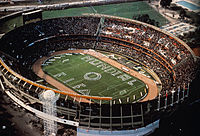
|

|
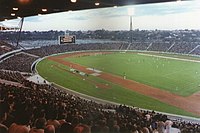
|
| Mar del Plata,Buenos Aires Province | ||
| Estadio José María Minella | ||
| Capacity:43,542 | ||

| ||
| Rosario,Santa Fe | ||
| Estadio Gigante de Arroyito | ||
| Capacity:45,645 | ||
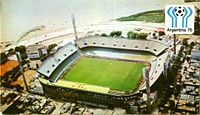
| ||
| Mendoza City,Mendoza | Stadiums in Buenos Aires | |
| Estadio Ciudad de Mendoza | ||
| Capacity:34,954 | ||

| ||
Match officials[edit]
- AFC
- CAF
- CONCACAF
- CONMEBOL
- UEFA
Squads[edit]
For a list of all squads that appeared in the final tournament, see1978 FIFA World Cup squads.
Seeding[edit]
| Pot 1 | Pot 2 | Pot 3 | Pot 4 |
|---|---|---|---|
|
Group stage[edit]
Group 1[edit]

| Pos | Team | Pld | W | D | L | GF | GA | GD | Pts | Qualification |
|---|---|---|---|---|---|---|---|---|---|---|
| 1 | 3 | 3 | 0 | 0 | 6 | 2 | +4 | 6 | Advance tosecond round | |
| 2 | 3 | 2 | 0 | 1 | 4 | 3 | +1 | 4 | ||
| 3 | 3 | 1 | 0 | 2 | 5 | 5 | 0 | 2 | ||
| 4 | 3 | 0 | 0 | 3 | 3 | 8 | −5 | 0 |
Group 2[edit]
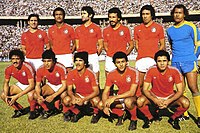
| Pos | Team | Pld | W | D | L | GF | GA | GD | Pts | Qualification |
|---|---|---|---|---|---|---|---|---|---|---|
| 1 | 3 | 2 | 1 | 0 | 4 | 1 | +3 | 5 | Advance tosecond round | |
| 2 | 3 | 1 | 2 | 0 | 6 | 0 | +6 | 4 | ||
| 3 | 3 | 1 | 1 | 1 | 3 | 2 | +1 | 3 | ||
| 4 | 3 | 0 | 0 | 3 | 2 | 12 | −10 | 0 |
| West Germany | 6–0 | |
|---|---|---|
| D. Müller H. Müller Rummenigge Flohe |
Report |
Group 3[edit]
| Pos | Team | Pld | W | D | L | GF | GA | GD | Pts | Qualification |
|---|---|---|---|---|---|---|---|---|---|---|
| 1 | 3 | 2 | 0 | 1 | 3 | 2 | +1 | 4 | Advance tosecond round | |
| 2 | 3 | 1 | 2 | 0 | 2 | 1 | +1 | 4 | ||
| 3 | 3 | 1 | 1 | 1 | 2 | 2 | 0 | 3 | ||
| 4 | 3 | 0 | 1 | 2 | 1 | 3 | −2 | 1 |
Group 4[edit]
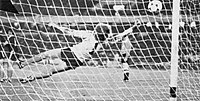
| Pos | Team | Pld | W | D | L | GF | GA | GD | Pts | Qualification |
|---|---|---|---|---|---|---|---|---|---|---|
| 1 | 3 | 2 | 1 | 0 | 7 | 2 | +5 | 5 | Advance tosecond round | |
| 2 | 3 | 1 | 1 | 1 | 5 | 3 | +2 | 3 | ||
| 3 | 3 | 1 | 1 | 1 | 5 | 6 | −1 | 3 | ||
| 4 | 3 | 0 | 1 | 2 | 2 | 8 | −6 | 1 |
| Netherlands | 3–0 | |
|---|---|---|
| Rensenbrink |
Report |
| Scotland | 1–1 | |
|---|---|---|
| Eskandarian |
Report | Danaeifard |
| Scotland | 3–2 | |
|---|---|---|
| Dalglish A. Gemmill |
Report | Rensenbrink Rep |
Second round[edit]
Group A[edit]
| Pos | Team | Pld | W | D | L | GF | GA | GD | Pts | Qualification |
|---|---|---|---|---|---|---|---|---|---|---|
| 1 | 3 | 2 | 1 | 0 | 9 | 4 | +5 | 5 | Advance tofinal | |
| 2 | 3 | 1 | 1 | 1 | 2 | 2 | 0 | 3 | Advance tothird place play-off | |
| 3 | 3 | 0 | 2 | 1 | 4 | 5 | −1 | 2 | ||
| 4 | 3 | 1 | 0 | 2 | 4 | 8 | −4 | 2 |
| Austria | 1–5 | |
|---|---|---|
| Obermayer |
Report | Brandts Rensenbrink Rep W. van de Kerkhof |
| Netherlands | 2–2 | |
|---|---|---|
| Haan R. van de Kerkhof |
Report | Abramczik D. Müller |
| Austria | 3–2 | |
|---|---|---|
| Vogts Krankl |
Report | Rummenigge Hölzenbein |
Group B[edit]

| Pos | Team | Pld | W | D | L | GF | GA | GD | Pts | Qualification |
|---|---|---|---|---|---|---|---|---|---|---|
| 1 | 3 | 2 | 1 | 0 | 8 | 0 | +8 | 5 | Advance tofinal | |
| 2 | 3 | 2 | 1 | 0 | 6 | 1 | +5 | 5 | Advance tothird place play-off | |
| 3 | 3 | 1 | 0 | 2 | 2 | 5 | −3 | 2 | ||
| 4 | 3 | 0 | 0 | 3 | 0 | 10 | −10 | 0 |
Knockout stage[edit]
Third place play-off[edit]
Final[edit]
Goalscorers[edit]
With six goals, Mario Kempes was the top scorer in the tournament. In total, 102 goals were scored by 62 players, with three of them credited as own goals.
- 6 goals
- 5 goals
- 4 goals
- 3 goals
- 2 goals
- 1 goal
 René Houseman
René Houseman Daniel Passarella
Daniel Passarella Alberto Tarantini
Alberto Tarantini Erich Obermayer
Erich Obermayer Walter Schachner
Walter Schachner Reinaldo
Reinaldo Zico
Zico Marc Berdoll
Marc Berdoll Bernard Lacombe
Bernard Lacombe Christian Lopez
Christian Lopez Michel Platini
Michel Platini Dominique Rocheteau
Dominique Rocheteau Károly Csapó
Károly Csapó András Tóth
András Tóth Sándor Zombori
Sándor Zombori Iraj Danaeifard
Iraj Danaeifard Hassan Rowshan
Hassan Rowshan Romeo Benetti
Romeo Benetti Franco Causio
Franco Causio Renato Zaccarelli
Renato Zaccarelli Víctor Rangel
Víctor Rangel Arturo Vázquez Ayala
Arturo Vázquez Ayala Dick Nanninga
Dick Nanninga René van de Kerkhof
René van de Kerkhof Willy van de Kerkhof
Willy van de Kerkhof César Cueto
César Cueto José Velásquez
José Velásquez Kazimierz Deyna
Kazimierz Deyna Andrzej Szarmach
Andrzej Szarmach Kenny Dalglish
Kenny Dalglish Joe Jordan
Joe Jordan Juan Manuel Asensi
Juan Manuel Asensi Dani
Dani Thomas Sjöberg
Thomas Sjöberg Mokhtar Dhouieb
Mokhtar Dhouieb Néjib Ghommidh
Néjib Ghommidh Ali Kaabi
Ali Kaabi Rüdiger Abramczik
Rüdiger Abramczik Bernd Hölzenbein
Bernd Hölzenbein Hansi Müller
Hansi Müller
- Own goals
 Andranik Eskandarian(against Scotland)
Andranik Eskandarian(against Scotland) Ernie Brandts(against Italy)
Ernie Brandts(against Italy) Berti Vogts(against Austria)
Berti Vogts(against Austria)
FIFA retrospective ranking[edit]
In 1986, FIFA published a report that ranked all teams in each World Cup up to and including 1986, based on progress in the competition, overall results and quality of the opposition.[27][28]The rankings for the 1978 tournament were as follows:
| R | Grp | Team | Pld | W | D | L | GF | GA | GD | Pts | Result |
|---|---|---|---|---|---|---|---|---|---|---|---|
| 1 | 1/B | 7 | 5 | 1 | 1 | 15 | 4 | +11 | 11 | Champion | |
| 2 | 4/A | 7 | 3 | 2 | 2 | 15 | 10 | +5 | 8 | Runners-up | |
| 3 | 3/B | 7 | 4 | 3 | 0 | 10 | 3 | +7 | 11 | Third place | |
| 4 | 1/A | 7 | 4 | 1 | 2 | 9 | 6 | +3 | 9 | Fourth place | |
| 5 | 2/B | 6 | 3 | 1 | 2 | 6 | 6 | 0 | 7 | Eliminated in the second group stage | |
| 6 | 2/A | 6 | 1 | 4 | 1 | 10 | 5 | +5 | 6 | ||
| 7 | 3/A | 6 | 3 | 0 | 3 | 7 | 10 | −3 | 6 | ||
| 8 | 4/B | 6 | 2 | 1 | 3 | 7 | 12 | −5 | 5 | ||
| 9 | 2 | 3 | 1 | 1 | 1 | 3 | 2 | +1 | 3 | Eliminated in the first group stage | |
| 10 | 3 | 3 | 1 | 1 | 1 | 2 | 2 | 0 | 3 | ||
| 11 | 4 | 3 | 1 | 1 | 1 | 5 | 6 | −1 | 3 | ||
| 12 | 1 | 3 | 1 | 0 | 2 | 5 | 5 | 0 | 2 | ||
| 13 | 3 | 3 | 0 | 1 | 2 | 1 | 3 | −2 | 1 | ||
| 14 | 4 | 3 | 0 | 1 | 2 | 2 | 8 | −6 | 1 | ||
| 15 | 1 | 3 | 0 | 0 | 3 | 3 | 8 | −5 | 0 | ||
| 16 | 2 | 3 | 0 | 0 | 3 | 2 | 12 | −10 | 0 |
Notes[edit]
References[edit]
- ^"1982 FIFA World Cup Technical Report"(PDF).FIFA Technical Group. 1982. Archived fromthe original(PDF)on 6 January 2010.
- ^ab"1978 FIFA World Cup Argentina - Awards".FIFA.Fédération Internationale de Football Association. Archived fromthe originalon 7 March 2015.Retrieved3 February2019.
- ^Forrest, David (5 July 2017)."The political message hidden on the goalposts at the 1978 World Cup".The Guardian.Retrieved30 June2021.
- ^abcdSmith, B.L. (March 2002)."The Argentinian Junta and the Press in the Run-up to the 1978 World Cup".Soccer & Society.3(1): 69–78.doi:10.1080/714004869.ISSN1466-0970.
- ^Pablo Llonto,"I Mondiali della vergogna. I campionati di Argentina '78 e la dittatura"("The World Cup of the Shame. Argentina '78 and the dictatorship"), Edizioni Alegre, Rome 2010, p. 38.
- ^abMaier, Hanns J (June 1979). "1986 - World Cup without a home?".World Soccer.pp. 24–25.
- ^"1978 FIFA World Cup Argentina Preliminaries".FIFA. Archived fromthe originalon 20 December 2013.
- ^Winner, David (21 June 2008)."But Was This The Beautiful Game's Ugliest Moment?".Financial Times.Archived fromthe originalon 11 June 2010.Retrieved15 June2014.
- ^McDonnell, Patrick J. (28 June 2008)."Argentina's bittersweet win".LA Times.Retrieved7 April2010.
- ^Scharpf, Adam; Gläßel, Christian; Edwards, Pearce (August 2023)."International Sports Events and Repression in Autocracies: Evidence from the 1978 FIFA World Cup".American Political Science Review.117(3): 909–926.doi:10.1017/S0003055422000958.ISSN0003-0554.
- ^Doyle, Paul (16 April 2008)."Kidnappers made Cruyff miss World Cup".The Guardian.London.Retrieved20 June2008.
- ^Cordolcini, Alec (2011).Pallone desaparecido - L'Argentina dei generali e il Mondiale del 1978(in Italian). Turin: Bradipolibri. p. 110.
- ^abTomlinson, Alan; Young, Christopher, eds. (2006).National identity and global sports events: culture, politics, and spectacle in the Olympics and the football World Cup.SUNY series on sport, culture, and social relations. Albany, NY: State University of New York Press.ISBN978-0-7914-6615-5.
- ^abcHersey, Will (16 June 2018)."Remembering Argentina 1978: The Dirtiest World Cup of All Time".Esquire.
- ^Spurling, Jon (11 March 2016)."Argentina's 1978 World Cup Run: The Ugly Truth".Archived fromthe originalon 29 October 2018.Retrieved29 October2018.
- ^Rein, Raanan (2010).Argentine Jews or Jewish Argentines? essays on ethnicity, identity, and diaspora.Jewish identities in a changing world. Leiden: Brill.ISBN978-90-04-17913-4.
- ^ab"El capitán de Perú en el 78: 'Pongo la mano en el fuego por mis compañeros'".El Mundo(in Spanish).
- ^"Keeping the Dark Side of Soccer Away From the City of Light".The New York Times.7 June 1998.Retrieved22 June2021.
- ^"Niega Videla arreglo de partidos en Argentina 1978"(in Spanish). Excelsior. 26 April 2012.
- ^"Bungs and bribes football can't kick this habit".The Independent.London. 15 March 1995.Archivedfrom the original on 1 May 2022.Retrieved22 June2021.
- ^"Argentina's 1978 World Cup win against Peru was fixed in a brutal political deal, former senator says".Yahoo Sports.9 February 2012.
- ^"Summary of Maradona's life".vivadiego.Archived fromthe originalon 2 November 2000.
- ^"The Netherlands pay back controversial loss to Argentina".CNN.4 July 1998.Retrieved20 April2010.
- ^Jon (4 February 2008)."Al sueño de Tucumán lo invadió la frustración".
- ^"Estadio José Amalfitani".The Stadium Guide. 22 March 2019.
- ^"YouTube".YouTube.Archived fromthe originalon 2 January 2016.Retrieved12 June2015.
- ^ab"page 45"(PDF).Archived fromthe original(PDF)on 14 June 2010.Retrieved2 March2012.
- ^ab"FIFA World Cup: Milestones, facts & figures. Statistical Kit 7"(PDF).FIFA.26 March 2013. Archived fromthe original(PDF)on 21 May 2013.


